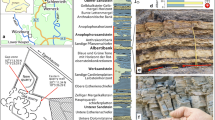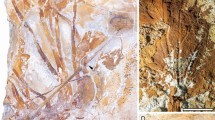Abstract
The Osmundaceae family is the sister group to all other extant leptosporangiate ferns. Its rich fossil record has enabled detailed reconstructions of the evolutionary history of the group. Fossil evidence for today’s Southern Hemisphere subtribe Todeinae, however, has been difficult to accumulate, with only two unambiguous fossil occurrences of modern Todea. Here, we describe a silicified Todea stem from the Eocene Laguna del Hunco lagerstätte of Patagonia. The stem contains a heterogeneous outer cortex with distinct fibrous rings surrounding the leaf traces, indicative of subtribe Todeinae; nests of thick-walled fibres associated with departing leaf traces together with the sclerenchymatous pith and with abundant sclerenchyma fibres in the inner stipe cortex enable assignment to Todea. The stem differs from T. tidwellii—the only other known fossil Todea stem described thus far—mainly in lacking sclerenchyma lining the adaxial concavity of the stipe bundle. Co-occurrence with sterile foliage fragments indicates that the stem may belong to Todea amissa, a species that was initially described based on frond compressions from the same deposits. Our finding corroborates the widely disjunct Gondwanan distribution of Todea across the Southern Hemisphere in the past, and provides an impetus to re-assess genetic divergence between the relictual African and Australasian populations of Todea barbara today in order to resolve the evolutionary history of the group more clearly. Finally, this first report of structurally preserved plant remains from Laguna del Hunco highlights the thus far untapped potential for anatomical preservation in this important fossil lagerstätte.




Similar content being viewed by others
References
Arnold, C.A. 1964. Mesozoic and Tertiary fern evolution and distribution. Memoirs of the Torrey Botanical Club 21: 58–66.
Bernhardi, J.J. 1801. Tentamen alterum filices in genera redigendi. In Journal für die Botanik, 2[1800](1–2), ed. H.A. Schrader, 121–136. Göttingen: H. Dieterich.
Bomfleur, B., S. McLoughlin, and V. Vajda. 2014. Fossilized nuclei and chromosomes reveal 180 million years of genomic stasis in royal ferns. Science 343: 1376–1377.
Bomfleur, B., G.W. Grimm, and S. McLoughlin. 2015. Osmunda pulchella sp. nov. from the Jurassic of Sweden—reconciling molecular and fossil evidence in the phylogeny of Osmundaceae. BMC Evolutionary Biology 15: 126.
Bomfleur, B., G.W. Grimm, and S. McLoughlin. 2017. The fossil Osmundales (Royal Ferns)—a phylogenetic network analysis, revised taxonomy, and evolutionary classification of anatomically preserved trunks and rhizomes. PeerJ. https://doi.org/10.7717/peerj.3433.
Cantrill, D.J. 1997. The pteridophyte Ashicaulis livingstonensis (Osmundaceae) from the Upper Cretaceous of Williams Point, Livingston Island, Antarctica. New Zealand Journal of Geology and Geophysics 40: 315–323.
Carvalho, M.R., P. Wilf, E.J. Hermsen, M.A. Gandolfo, N.R. Cúneo, and K.R. Johnson. 2013. First record of Todea (Osmundaceae) in South America, from the early Eocene paleorainforests of Laguna del Hunco (Patagonia, Argentina). American Journal of Botany 100(9): 1831–1848.
Escapa, I.H., and N.R. Cúneo. 2012. Fertile Osmundaceae from the early jurassic of Patagonia. International Journal of Plant Sciences 173: 54–66.
Gould, R.E. 1970. Palaeosmunda, a new genus of siphonostelic osmundaceous trunks from the Upper Permian of Queensland. Palaeontology 13: 10–28.
Hennipman, E. 1968. A new Todea from New Guinea with remarks on the generic delimitation in recent Osmundaceae (Filices). Blumea 16: 105–108.
Herbst, R. 2001. A revision of the anatomy of Millerocaulis patagonica (Archangelsky and de la Sota) Tidwell (Filices, Osmundaceae) from the Middle Jurassic of Santa Cruz Province, Argentina. Asociación Paleontológica Argentina, Publicación Especial 8: 39–48.
Hewitson, W. 1962. Comparative morphology of the Osmundaceae. Annals of the Missouri Botanical Garden 49: 57–93.
Jones, T.P., and N.P. Rowe. 1999. Fossil plants and spores: Modern techniques. London: Geological Society.
Jud, N.A., G.W. Rothwell, and R.A. Stockey. 2008. Todea from the Lower Cretaceous of western North America: Implications for the phylogeny, systematics, and evolution of modern Osmundaceae. American Journal of Botany 95: 330–339.
Kato, M. 2007. Distribution of Osmundaceae. Bulletin of the National Museum of Nature and Science, Series B 33: 81–90.
Kidston, R., and D.T. Gwynne-Vaughan. 1909. On the fossil Osmundaceae. Part III. Transactions of the Royal Society of Edinburgh 46: 651–667.
Link, H.F. 1833. Hortus Regius Botanicus Berolinensis, Tomus II. Berlin: G. Reimer.
Martynov [Martinov], I.I. 1820. Tekhno-Botaničeskiy Slovar. St. Peterburg: Imperatorskaya Rossiskaya Akademiâ. (in Russian).
Miller, C.N. 1971. Evolution of the fern family Osmundaceae based on anatomical studies. Contribution from the Museum of Paleontology 23: 105–169.
Moore, T. 1857. Index Filicum: A synopsis, with characters, of the genera, and an enumeration of the species of ferns, with synonymes, references, etc. London: W. Pamplin.
Phipps, C.J., T.N. Taylor, E.L. Taylor, R. Cúneo, L.D. Boucher, and X. Yao. 1998. Osmunda (Osmundaceae) from the Triassic of Antarctica: An example of evolutionary stasis. American Journal of Botany 85: 888–895.
PPG (Pteridophyte Phylogeny Group) I. 2016. A community-derived classification for extant lycophytes and ferns. Journal of Systematics and Evolution 54: 563–603.
Scotese, C.R. 2004. A continental drift flipbook. The Journal of Geology 112: 729–741.
Serbet, R., and G.W. Rothwell. 1999. Osmunda cinnamomea (Osmundaceae) in the Upper Cretaceous of Western North America: Additional evidence for exceptional species longevity among filicalean ferns. International Journal of Plant Sciences 160: 425–433.
Seward, A.C., and S.O. Ford. 1903. The anatomy of Todea, with notes on the geological history and affinities of the Osmundaceae. Transactions of the Linnean Society of London (2nd Series, Botany) 6: 237–260.
Sharma, B.D., D.R. Bohra, and R. Singh. 1979. Osmundacaulis estipulare sp. nov—a petrified rhizome from Jurassic of Rajmahal Hills, India. Phytomorphology 29: 46–52.
Taylor, T.N., E.L. Taylor, B. Meyer-Berthaud, J.L. Isbell, and N.R. Cúneo. 1990. Triassic osmundaceous ferns from the Allan Hills, southern Victoria Land. Antarctic Journal of the United States 25(5): 18–20.
Tidwell, W.D., and S.R. Ash. 1994. A review of selected Triassic to Early Cretaceous ferns. Journal of Plant Research 107: 417–442.
Vera, I.E. 2008. Proposal to emend the genus Millerocaulis Erasmus ex Tidwell 1986 to recombine the genera Ashicaulis Tidwell 1994 and Millerocaulis Tidwell emend. Tidwell 1994. Ameghiniana 45: 693–698.
Wilf, P., N.R. Cúneo, K.R. Johnson, J.F. Hicks, S.L. Wing, and J.D. Obradovich. 2003. High plant diversity in Eocene South America: Evidence from Patagonia. Science 300: 122–125.
Wilf, P., N.R. Cúneo, I.H. Escapa, D. Pol, and M.O. Woodburne. 2013. Splendid and seldom isolated: The palaeobiogeography of Patagonia. Annual Review of Earth and Planetary Sciences 41: 561–603.
Wilf, P., and I.H. Escapa. 2015. Green Web or megabiased clock? Plant fossils from Gondwanan Patagonia speak on evolutionary radiations. New Phytologist 207: 283–290.
Acknowledgements
We thank the initial finder of the specimen Pablo Puerta (Trelew) for his keen eyes during exploratory field work; Mariano Caffa (Trelew) for preparation of thin sections; Eduardo Ruigomez (Trelew) for collection support; N. Rubén Cúneo (Trelew) for permission to study the material; N. Rubén Cúneo and Peter Wilf (University Park, PA) for helpful discussion; Gar W. Rothwell (Corvallis, OR) and an anonymous reviewer for constructive criticism on an earlier version of the manuscript; and Mike Reich (Munich) for editorial handling. Financial support for this project was provided by the Swedish Research Council (VR Project 2014-5232 to B.B.) and the National Science Foundation (Grant DEB-1556666 to Peter Wilf).
Author information
Authors and Affiliations
Corresponding author
Additional information
Handling Editor: Mike Reich.
Rights and permissions
About this article
Cite this article
Bomfleur, B., Escapa, I. A silicified Todea trunk (Osmundaceae) from the Eocene of Patagonia. PalZ 93, 543–548 (2019). https://doi.org/10.1007/s12542-019-00479-6
Received:
Accepted:
Published:
Issue Date:
DOI: https://doi.org/10.1007/s12542-019-00479-6




